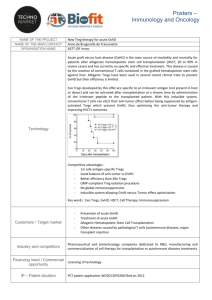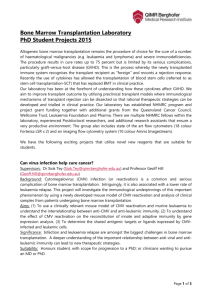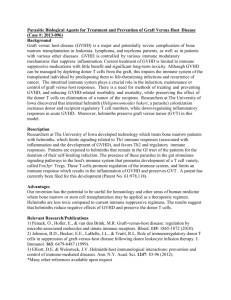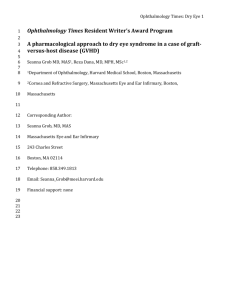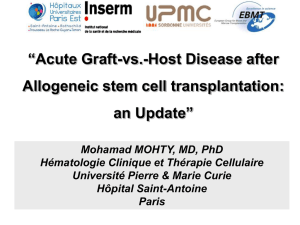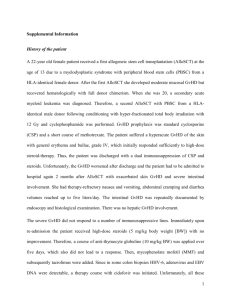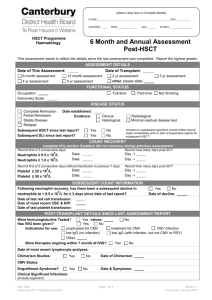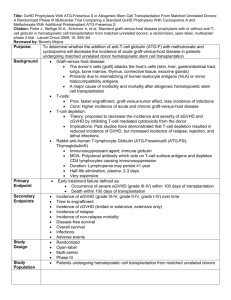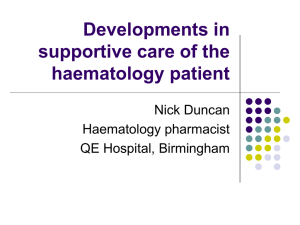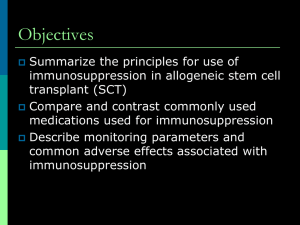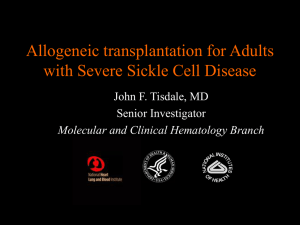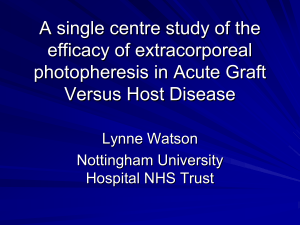Projects & contact details
advertisement
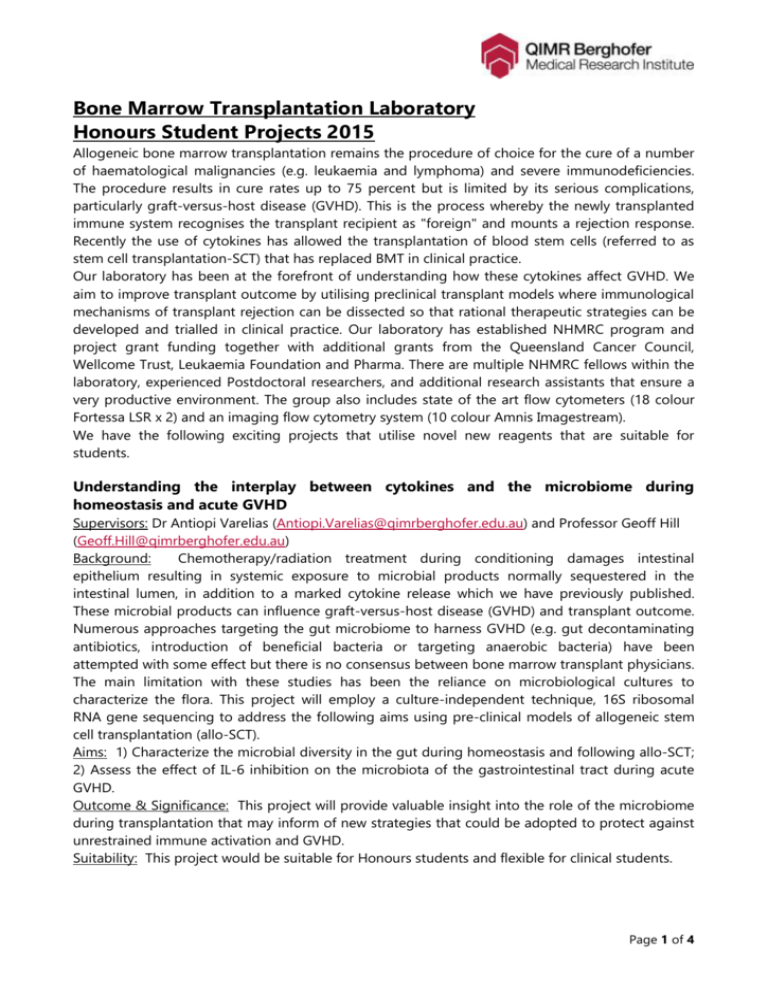
Bone Marrow Transplantation Laboratory Honours Student Projects 2015 Allogeneic bone marrow transplantation remains the procedure of choice for the cure of a number of haematological malignancies (e.g. leukaemia and lymphoma) and severe immunodeficiencies. The procedure results in cure rates up to 75 percent but is limited by its serious complications, particularly graft-versus-host disease (GVHD). This is the process whereby the newly transplanted immune system recognises the transplant recipient as "foreign" and mounts a rejection response. Recently the use of cytokines has allowed the transplantation of blood stem cells (referred to as stem cell transplantation-SCT) that has replaced BMT in clinical practice. Our laboratory has been at the forefront of understanding how these cytokines affect GVHD. We aim to improve transplant outcome by utilising preclinical transplant models where immunological mechanisms of transplant rejection can be dissected so that rational therapeutic strategies can be developed and trialled in clinical practice. Our laboratory has established NHMRC program and project grant funding together with additional grants from the Queensland Cancer Council, Wellcome Trust, Leukaemia Foundation and Pharma. There are multiple NHMRC fellows within the laboratory, experienced Postdoctoral researchers, and additional research assistants that ensure a very productive environment. The group also includes state of the art flow cytometers (18 colour Fortessa LSR x 2) and an imaging flow cytometry system (10 colour Amnis Imagestream). We have the following exciting projects that utilise novel new reagents that are suitable for students. Understanding the interplay between cytokines and the microbiome during homeostasis and acute GVHD Supervisors: Dr Antiopi Varelias (Antiopi.Varelias@qimrberghofer.edu.au) and Professor Geoff Hill (Geoff.Hill@qimrberghofer.edu.au) Background: Chemotherapy/radiation treatment during conditioning damages intestinal epithelium resulting in systemic exposure to microbial products normally sequestered in the intestinal lumen, in addition to a marked cytokine release which we have previously published. These microbial products can influence graft-versus-host disease (GVHD) and transplant outcome. Numerous approaches targeting the gut microbiome to harness GVHD (e.g. gut decontaminating antibiotics, introduction of beneficial bacteria or targeting anaerobic bacteria) have been attempted with some effect but there is no consensus between bone marrow transplant physicians. The main limitation with these studies has been the reliance on microbiological cultures to characterize the flora. This project will employ a culture-independent technique, 16S ribosomal RNA gene sequencing to address the following aims using pre-clinical models of allogeneic stem cell transplantation (allo-SCT). Aims: 1) Characterize the microbial diversity in the gut during homeostasis and following allo-SCT; 2) Assess the effect of IL-6 inhibition on the microbiota of the gastrointestinal tract during acute GVHD. Outcome & Significance: This project will provide valuable insight into the role of the microbiome during transplantation that may inform of new strategies that could be adopted to protect against unrestrained immune activation and GVHD. Suitability: This project would be suitable for Honours students and flexible for clinical students. Page 1 of 4 Dissecting IL-6 receptor signalling following allo-SCT: membrane bound (classical) versus soluble (trans) receptor signalling. Supervisors: Dr Antiopi Varelias (Antiopi.Varelias@qimrberghofer.edu.au) and Professor Geoff Hill (Geoff.Hill@qimrberghofer.edu.au) Background: IL-6 has been shown to be required for restoring mucosal integrity after intestinal injury however we show that it is detrimental and drives acute GVHD following allo-SCT. Are these contrasting effects of IL-6 regulated by the mode of cytokine receptor signalling? This project will examine the contribution of membrane bound IL-6 receptor signalling (classical) versus soluble IL-6 receptor signalling (trans) to development of GVHD following allogeneic stem cell transplantation (allo-SCT). In the clinical setting, we observed an increase in systemic IL-6 and soluble IL-6R levels in allo-SCT recipients suggesting contribution of the pro-inflammatory IL-6 trans-signalling pathway. Moreover, we showed that blockade of the IL-6R with TCZ mAb reduced the incidence of acute GVHD however TCZ mAb inhibits both signalling pathways and hence the responsible signalling pathway cannot be discerned. This project will employ various mouse models of allo-SCT to interrogate the role of IL-6 signalling in mediating GVHD pathogenesis. Aims: 1) Assess the systemic soluble IL-6R and soluble gp130 expression levels in mouse models of allo-SCT; 2) Delineate the contribution of the IL-6 trans-signalling pathway in the development of GVHD. Outcome & Significance: This project will further our understanding of the mechanism by which IL6 signalling mediates GVHD and may inform of new strategies that could be undertaken to abrogate the development of GVHD. Suitability: This project would be suitable for Honours students and flexible for clinical students. To determine the ability of leukaemia to initiate graft-versus-leukaemia effects after allogeneic bone marrow transplantation Supervisors: Dr Motoko Koyama (Motoko.Koyama@qimrberghofer.edu.au) and Professor Geoff Hill (Geoff.Hill@qimrberghofer.edu.au) Background: Allogeneic bone marrow transplantation (BMT) is a preferred curative therapy in the majority of haematological malignancies and severe immunodeficiencies. The therapeutic potential of this procedure relates to the graft-versus-leukaemia (GVL) effect, which eradicates host malignancy after BMT and is mediated by donor T and NK cells. However, GVL effects are closely associated with graft-versus-host disease (GVHD), the major limitation of allogeneic haematopoietic stem cell transplantation (HSCT). GVHD occurs in the majority (50-70%) of BMT recipients and is responsible for the transplant-related mortality of up to 50%. Clearly there is a pressing need for new strategy to enhance GVL effects whilst suppressing detrimental GVHD. Aims: 1) To confirm the capacity of leukaemia to present antigen and directly prime donor T cells after BMT to initiate immunological disease control. 2) To elucidate the type of progenitor / stem cells in leukaemia that preferentially present antigen. Significance: Although MHC is clearly required for donor T cells to mediate effective cytotoxic responses against leukaemia, little is known about the ability of leukaemia to initiate immune responses via MHC. Understanding this process may help explain why some leukaemia is more responsive to GVL effects than others and provide a rationale for the modification of leukaemia to enhance immunogenicity after BMT, thus improving survival. Suitability: This would be suitable for Honours student project. Page 2 of 4 Can virus infection help cure cancer? Supervisors: Dr Siok Tey (Siok.Tey@qimrberghofer.edu.au) and Professor Geoff Hill (Geoff.Hill@qimrberghofer.edu.au) Background: Cytomegalovirus (CMV) infection (or reactivation) is a common and serious complication of bone marrow transplantation. Intriguingly, it is also associated with a lower rate of leukaemia relapse. This project will investigate the immunological underpinnings of this important phenomenon by using a newly developed mouse model of CMV reactivation and analysis of clinical samples from patients undergoing bone marrow transplantation. Aims: (1) To use a clinically relevant mouse model of CMV reactivation and murine leukaemia to understand the interrelationship between anti-CMV and anti-leukemic immunity. (2) To understand the effect of CMV reactivation on the reconstitution of innate and adaptive immunity by gene expression analysis. (3) To determine the shared antigenic targets or ligands expressed by CMVinfected and leukemic cells. Significance: Infection and leukaemia relapse are amongst the biggest challenges in bone marrow transplantation. A deeper understanding of the important relationship between anti-viral and antileukemic immunity can lead to new therapeutic strategies. Suitability: Honours student, with scope for progression to a PhD; or clinicians wanting to pursue an MD or PhD. Characterising miRNA expression after bone marrow transplantation to develop novel therapeutics Supervisors: Dr Kate Gartlan (Kate.Gartlan@qimrberghofer.edu.au) and Professor Geoff Hill (Geoff.Hill@qimrberghofer.edu.au) Background: Micro RNAs (miRNAs) are small RNA molecules (~25 nucleotides) known to play an important role in regulating inflammation. Therefore miRNA may be a novel target to treat inflammatory diseases such as graft-versus-host disease (GVHD). GVHD develops in >50% of leukaemia patients that receive a donor stem cell/bone marrow transplant (SCT/BMT). GVHD has a major impact on the mortality and quality-of-life for these cancer survivors, however treatment options are very limited and steroid refractory GVHD patients (~20%) have particularly high mortality rates. Unfortunately, GVHD severity and tumour clearance are positively correlated, which means a balance must be struck between providing anti-tumour immunity and reducing the risks associated with GVHD. Our laboratory is therefore investigating novel therapeutics such as miRNAs to modulate inflammatory responses after BMT/SCT. Aims: We are currently offering a project designed to 1) characterise miRNA expression profiles in patient serum after BMT/SCT and 2) to evaluate potential inflammatory biomarkers of GVHD. Significance: New therapies are urgently needed to minimise the effects of GVHD after donor SCT/BMT. This project will use molecular and cell biology techniques and clinical samples to identify potential new targets for GVHD immunotherapy. Suitability: This project would suit either Honours or PhD students. Page 3 of 4 Modulating donor T cell polarisation after bone marrow transplantation to prevent graft-versus-host disease Supervisors: Dr Kate Gartlan (Kate.Gartlan@qimrberghofer.edu.au) and Professor Geoff Hill (Geoff.Hill@qimrberghofer.edu.au) Background: Stem cell transplantation (SCT) is an effective cancer treatment, however its application is limited by graft-versus-host disease (GVHD), which has a major impact on patient morbidity and mortality. Unfortunately, GVHD severity and tumour clearance are positively correlated and therefore new therapies designed to reduce GVHD must be targeted, such that antitumour immunity is maintained. Donor T cell polarization is a critical factor influencing the severity and tissue distribution of graft-versus-host disease (GVHD) and the potency of graft-versusleukaemia (GVL) effects after allo-SCT. We have identified a pathogenic donor T cell differentiation program that exacerbates GVHD without contributing to tumour clearance, which is characterised by a unique transcription factor expression profile. Aims: This study will 1) examine T cell transcription factor expression after allo-SCT in both murine and clinical samples, and 2) utilise a small molecule inhibitor that modulates transcription factor expression to assess its therapeutic potential in the context of GVHD. Significance: This therapeutic approach is highly novel and will provide the first essential proof-ofconcept data to support small molecule modulation of T cell polarisation as a method for GVHD prevention and treatment. Suitability: This project would suit either Honours or PhD students. For more information about these projects, please contact the supervisors listed with each project. http://www.qimrberghofer.edu.au/page/Lab/Bone_Marrow_Transplantation/ Page 4 of 4
